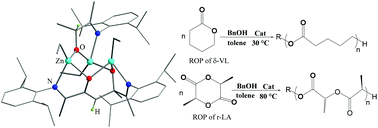Synthesis and structures of mono- and di-nuclear aluminium and zinc complexes bearing α-diimine and related ligands, and their use in the ring opening polymerization of cyclic esters†
Abstract
A series of organoaluminium imino-amido complexes of the type {[ArNC(Me2)C(Me)![[double bond, length as m-dash]](https://www.rsc.org/images/entities/char_e001.gif) NAr]AlMe2} (Ar = 2,6-iPr2C6H3 (1), Ar = 2,6-Et2C6H3 (2); Ar = 2,6-Me2C6H3 (3) have been prepared via reaction of AlR3 and the respective α-diimine. Similar reaction of the bis(α-diimine) [ArN
NAr]AlMe2} (Ar = 2,6-iPr2C6H3 (1), Ar = 2,6-Et2C6H3 (2); Ar = 2,6-Me2C6H3 (3) have been prepared via reaction of AlR3 and the respective α-diimine. Similar reaction of the bis(α-diimine) [ArN![[double bond, length as m-dash]](https://www.rsc.org/images/entities/char_e001.gif) C(Me)C(Me)
C(Me)C(Me)![[double bond, length as m-dash]](https://www.rsc.org/images/entities/char_e001.gif) N-]2 (Ar = 2,6-iPr2C6H3) with AlMe3 afforded the bimetallic complex [ArN−C(Me)2C(Me)
N-]2 (Ar = 2,6-iPr2C6H3) with AlMe3 afforded the bimetallic complex [ArN−C(Me)2C(Me)![[double bond, length as m-dash]](https://www.rsc.org/images/entities/char_e001.gif) NAlMe2]2 (4), whilst reaction of the acetyl-imino compound [O
NAlMe2]2 (4), whilst reaction of the acetyl-imino compound [O![[double bond, length as m-dash]](https://www.rsc.org/images/entities/char_e001.gif) C(Me)C(Me)
C(Me)C(Me)![[double bond, length as m-dash]](https://www.rsc.org/images/entities/char_e001.gif) NAr] (Ar = 2,6-Et2C6H3) with AlMe3 afforded the bimetallic complex {[OCMe2CH(Me)
NAr] (Ar = 2,6-Et2C6H3) with AlMe3 afforded the bimetallic complex {[OCMe2CH(Me)![[double bond, length as m-dash]](https://www.rsc.org/images/entities/char_e001.gif) NAr]AlMe2}2 (5). In related organozinc chemistry, we have isolated {[ArNC(Me)(Et)C(Me)
NAr]AlMe2}2 (5). In related organozinc chemistry, we have isolated {[ArNC(Me)(Et)C(Me)![[double bond, length as m-dash]](https://www.rsc.org/images/entities/char_e001.gif) NAr]ZnEt} (Ar = 2,6-iPr2C6H3, 6) and the trinuclear complex {[ArN
NAr]ZnEt} (Ar = 2,6-iPr2C6H3, 6) and the trinuclear complex {[ArN![[double bond, length as m-dash]](https://www.rsc.org/images/entities/char_e001.gif) C(Me)COCHCO(Me)C(Me)
C(Me)COCHCO(Me)C(Me)![[double bond, length as m-dash]](https://www.rsc.org/images/entities/char_e001.gif) NAr][OCH(Me)C(Me)
NAr][OCH(Me)C(Me)![[double bond, length as m-dash]](https://www.rsc.org/images/entities/char_e001.gif) NAr](ZnEt)3} (Ar = 2,6-iPr2C6H3, 7) from reactions of ZnEt2 with ArN
NAr](ZnEt)3} (Ar = 2,6-iPr2C6H3, 7) from reactions of ZnEt2 with ArN![[double bond, length as m-dash]](https://www.rsc.org/images/entities/char_e001.gif) C(Me)C(Me)
C(Me)C(Me)![[double bond, length as m-dash]](https://www.rsc.org/images/entities/char_e001.gif) NAr or [O
NAr or [O![[double bond, length as m-dash]](https://www.rsc.org/images/entities/char_e001.gif) C(Me)C(Me)
C(Me)C(Me)![[double bond, length as m-dash]](https://www.rsc.org/images/entities/char_e001.gif) NAr], respectively. Reaction of the bis(α-diimine), LiPr–N2–ArCH2Ar–N2, derived from 4,4′-methylenebis(2,6-diisopropylaniline), with ZnCl2 affords [LiPr–N2–ArCH2Ar–N2(ZnCl2)2] (8). The molecular structures of complexes 1–8 are reported. Preliminary results of the ability of 1–8, along with the previously reported metal–metal bonded complex {[ArN
NAr], respectively. Reaction of the bis(α-diimine), LiPr–N2–ArCH2Ar–N2, derived from 4,4′-methylenebis(2,6-diisopropylaniline), with ZnCl2 affords [LiPr–N2–ArCH2Ar–N2(ZnCl2)2] (8). The molecular structures of complexes 1–8 are reported. Preliminary results of the ability of 1–8, along with the previously reported metal–metal bonded complex {[ArN![[double bond, length as m-dash]](https://www.rsc.org/images/entities/char_e001.gif) C(Me)C(Me)
C(Me)C(Me)![[double bond, length as m-dash]](https://www.rsc.org/images/entities/char_e001.gif) NAr]Al(THF)}2 (9), to act as catalysts for the ring opening polymerization (ROP) of the cyclic esters ε-caprolactone (ε-CL), δ-valerolactone (δ-VL) and rac-lactide (r-LA) are presented. For ε-CL and δ-VL, best results were obtained using the metal–metal bonded complex 9. For r-LA, the Al-based systems exhibited moderate activity affording only liquid oligomers, whilst the Zn-based systems performed better affording at 80 °C isotactic PLA with Mnca. 10 kDa with conversions of up to 66%. The co-polymerization of ε-CL with δ-VL was also examined, and differing preferences were noted for monomer incorporation.
NAr]Al(THF)}2 (9), to act as catalysts for the ring opening polymerization (ROP) of the cyclic esters ε-caprolactone (ε-CL), δ-valerolactone (δ-VL) and rac-lactide (r-LA) are presented. For ε-CL and δ-VL, best results were obtained using the metal–metal bonded complex 9. For r-LA, the Al-based systems exhibited moderate activity affording only liquid oligomers, whilst the Zn-based systems performed better affording at 80 °C isotactic PLA with Mnca. 10 kDa with conversions of up to 66%. The co-polymerization of ε-CL with δ-VL was also examined, and differing preferences were noted for monomer incorporation.



 Please wait while we load your content...
Please wait while we load your content...